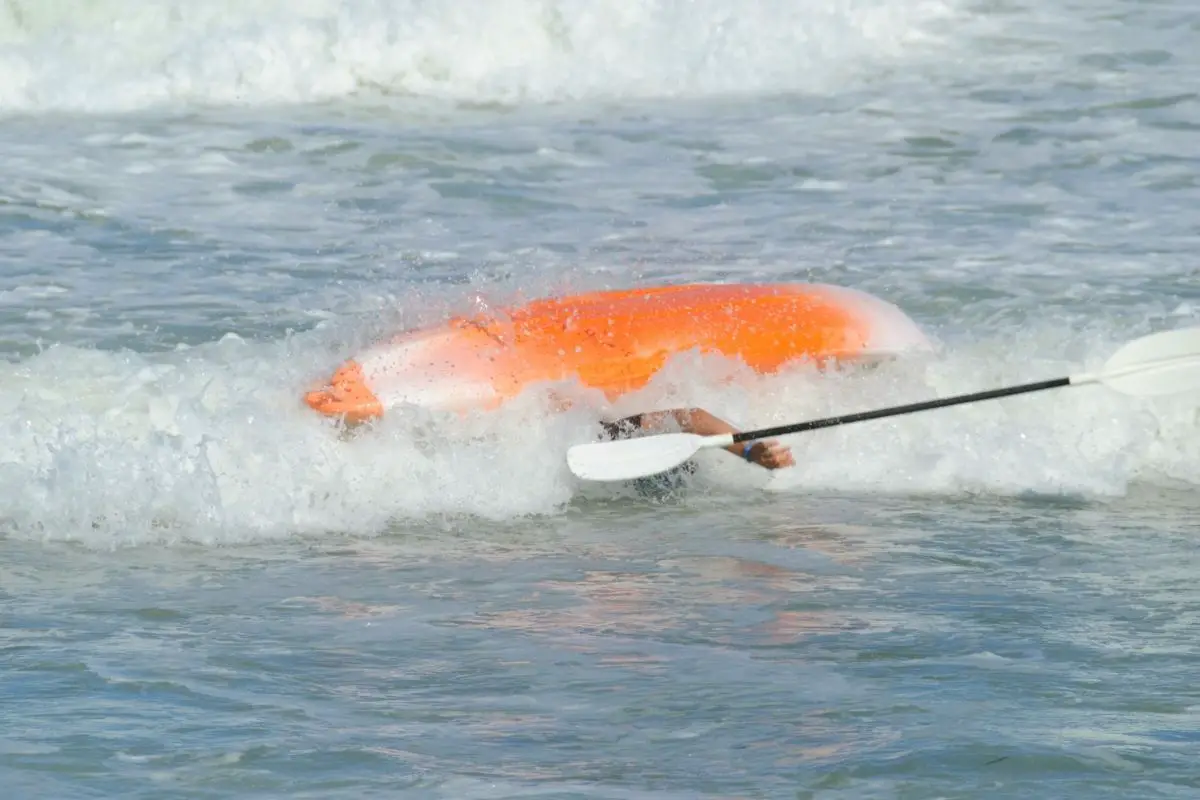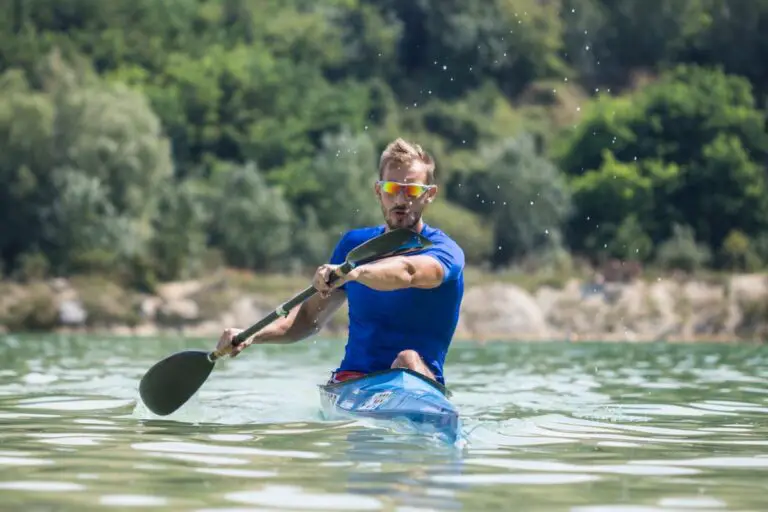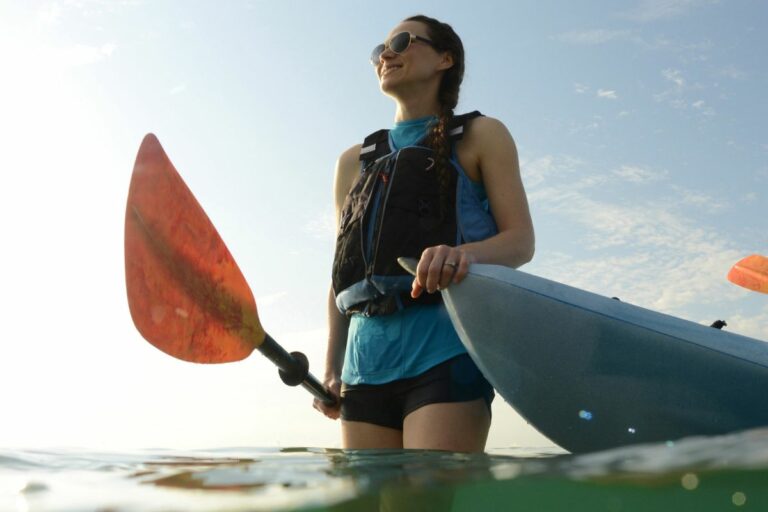Can You Sink A Kayak? [Should You Worry?]
Kayaks are mainly designed to safely float over the surface of the water while carrying one or two paddlers along with their gear. Many believe that the way kayaks are designed makes them practically unsinkable, but that’s not always the case.
So, can you sink a kayak? You can potentially sink a kayak if you’re carrying more weight than the kayak handle or if huge amounts of water get into the kayak’s hull. Some kayaks might be more prone to sinking than others depending on their design. Sit-on-top kayaks are the least likely to sink because they’re designed with scupper holes that make them self-bailing.
Keep reading to learn more about different kayak designs, what it actually takes to sink a kayak, and how to prevent your kayak from sinking.
Table of Contents
What Are the Main Types of Kayak Design?

Kayaks are classified into two main types according to their design which are sit-on-top kayaks and sit-inside kayaks.
Sit-on-top kayaks are designed without an enclosed cockpit which allows water to splash onto the surface of the kayak. They are usually short with a wide beam which makes them highly stable and less likely to capsize.
Sit-inside kayaks, on the other hand, are designed with an enclosed cockpit. They are usually long with a narrow beam which decreases their stability but increases their speed.
To learn more about what sets them apart, check out this full comparison of sit-on-top vs sit-in kayaks.
What Does It Take to Actually Sink a Kayak?

Sinking a kayak is a rare occurrence and some kayaks are more likely to sink than others because of the way they’re designed. Generally, sit-on-top kayaks are considered almost impossible to sink compared to sit-inside kayaks.
Before getting into what it takes to actually sink a kayak, you first need to learn the difference between a kayak sinking and a kayak getting swamped.
The term ‘swamped’ is used to refer to a kayak that gets filled with water so it will be barely submerged under the surface without fully sinking. While sit-on-top kayaks might be impossible to fully sink, they can easily get swamped due to the lack of a cockpit. Sit-inside kayaks, on the other hand, are more likely to fully sink due to the presence of an enclosed cockpit.
Now, to understand what causes a kayak to fully sink, you need to understand the opposing forces that are working on the body of the kayak.
- The first force is the buoyancy force which acts upwards and prevents your kayak from getting pulled down into the water.
- The second force is the gravity force which acts downwards and pulls your kayak down into the water. It’s mainly affected by the kayak’s weight as well as your weight and the weight of your gear.
To make it simple, the main reason that will cause your kayak to fully sink is adding more weight onto the kayak until you exceed its maximum weight capacity.
As more water gets into the kayak, it will become heavier and the force of gravity will start pulling it under the water. The more the kayak gets underwater, the more buoyancy it will experience and it will feel almost like the water is pushing the kayak back.
At a certain point, the weight of the water in the kayak combined with your weight and the weight of your gear will exceed the weight capacity that the kayak can handle and the water volume inside the kayak will become more than the volume of the water displaced which will cause the kayak to fully sink.
Here is a simple video that shows how a kayak is tested for buoyancy:
How to Stop Your Kayak from Sinking?
In order to stop your kayak from sinking you mainly need to avoid exceeding the kayak’s maximum weight capacity by considering your weight and the weight of the gear, you bring abroad before going on your trip. You also need to make sure that your kayak isn’t filling with water as this will add more weight.
How to Stop Your Kayak from Filling with Water?
To stop a sit-inside kayak from filling with water, you need to make sure there are bulkheads.
Sit-inside kayaks have sealed hatches that allow you to access storage areas within the hulls. These sealed hatches manage to trap air within creating a watertight and airtight space. So, the water will not enter the hull even if the kayak capsizes.
With sit-top kayaks, it’s much easier to stop water from filling the kayak. That is because they come with four holes in the bottom of the hull that are known as scupper holes. The purpose of these holes is to drain out any water that enters the kayak and prevent it from pooling below the paddler.
Do Kayak Flip Over Easily?
Sit-on-top kayaks generally do not flip over as easily as sit-inside kayaks. That is because they’re designed in a way that gives a higher degree of initial stability.
However, the chances of your kayak flipping over depend on factors than the kayak’s design such as the paddler’s skill and technique or the water condition
Will a Kayak Sink If It Flips Over?
A Kayak might sink if it flips over and a significant amount of water enters the hull. This is less likely to happen with sit-on-top kayaks as they don’t flip over easily and they have scupper holes to drain water.
With sit-inside kayaks, on the other hand, you need to make sure that all the storage hatches are sealed to prevent water from accumulating inside the kayak in case of capsizing.
What to Do If Your Kayaks Flips Over?
If you’re kayak flips over and you end in the water, you need to be able to safely get back into your kayak.
Kayak re-entry from the water is usually easier with sit-on-top kayaks but with sufficient practice, you should be able to do it with sit-inside kayaks as well.
Here are some simple steps you can follow to safely re-enter your kayak if it flips over:
- Make sure your kayak is upright. If it’s not, try to turn it over by firmly pushing on one side and pulling on the other.
- Swim to the back of the kayak then pull your chest up onto the deck. This can be easier if you kick with your legs in the water as if you’re getting out of a swimming pool.
- Slide your body toward the cockpit while using your arms to pull yourself towards it. Keep your legs hanging off for more stability.
- When you reach the cockpit, try to sit up and straddle the kayak then swing your legs through the water until you can sit low in the seat and pull your feet on top.
Related Questions
Can Kayak Paddles Sink?
Kayak paddles do not sink. Some of them float better than others on the water surface. How well they float depends on multiple factors such as the material used to manufacture the paddle, the shape and feathering of the blades, and the total weight of the paddle
Can You Get Stuck Upside Down in a Kayak?
You cannot get stuck upside down in a kayak. It’s impossible with sit-on-top kayaks as they do not have a cockpit. As for sit-inside kayaks, there is plenty of free space around the paddler’s torso which makes it easy to exit if the cockpit of the kayak gets flipped over.
Helpful Resources
Kayak your way to Freedom
- On a budget? Check out the best fishing kayaks under $500 here and the best Fishing Kayaks under $1,000 here. Or Check the best Cheap Kayaks here.
- Going fishing? Here are the best Ocean fishing kayaks, and here are the best River Fishing Kayaks.
- You can also find the best Fly Fishing Kayaks here and the best Bass Fishing Boats here.
- A bit experienced? Check out the best modular kayaks here and the best tandem fishing kayaks here.
- Looking for something special? Check out my favorite Ducky kayaks here.
- Navigate your way with these awesome and beginner-friendly Kayak compasses.
- Going Hunting? These Duck hunting kayaks will give you an unfair advantage!
- Have a need for speed? These motorized kayaks will get you moving.
- Protect yourself from the sun with these Kayak shades, and make your kayak more comfortable with these Kayak seats.
- Keep your feet dry and warm with these superb Kayaking shoes.
- Going Kayaking in cold water? Stay warm with these Kayaking gloves.
- Paddle Less, Fish More with the Best Kayak Motors
- Looking to get a trolling motor on your kayak? Check out the best kayak trolling motor mounts here.
If you like this article, please share it or pin it, you can find the share buttons below. We will really appreciate it ❤️





![The Best Kayaking Gloves in 2023 [After Testing Dozens]](https://outdoorskilled.com/wp-content/uploads/2023/04/kayak-gloves-768x512.jpg)


